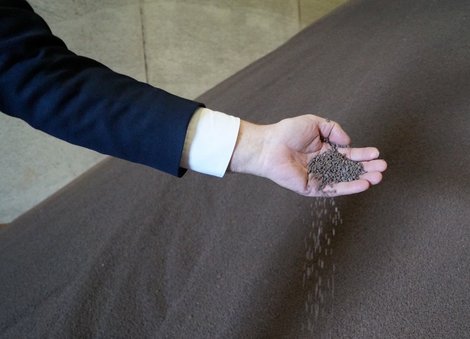The trend towards sustainability: Fertilizer pellets made from sewage sludge ash
Seraplant GmbH from Saxony-Anhalt is recovering phosphorus from sewage sludge ash in the only recycling plant of its kind in Germany

Phosphorus, which is an essential element for people, animals and plants, is in increasingly short supply and has therefore been on the EU’s list of critical raw materials for the last seven years. The new German Sewage Sludge Ordinance has introduced mandatory regulations concerning the recovery of this precious chemical element from 2029 onward. A company from Haldensleben near Magdeburg is already playing a pioneering role in the field of phosphorus recycling.
Henning Schmidt, managing partner of Seraplant GmbH, lets the fertilizer pellets trickle through his fingers. For him, things are coming full circle in the port of Haldensleben. The sewage sludge from wastewater treatment plants is being returned to arable fields in the states of Saxony-Anhalt, Thuringia, Saxony and Mecklenburg-Vorpommern, after being burnt and undergoing special treatment in the plant on the banks of the Mittelland Canal. “Our aim is to use ash from the region as fertilizer in the region,” explains Schmidt, who co-founded the company in 2016.
Limited resources from countries in crisis
Around 80 percent of the world’s phosphorus deposits are located in the Western Sahara region of Morocco. Phosphorus is also found in Russia, the Middle East and China. It is not simply that the resources are finite, but also that there are no natural deposits of the material in Germany. Europe still relies on imports of the critical raw material. However, the mining process uses large amounts of energy and produces a significant environmental impact.
“Our aim is to convert phosphorus from sewage sludge ash into a form available to plants and to replace mineral phosphorus fertilizer. This is achieved together with our partner Glatt Ingenieurtechnik GmbH from Thuringia, one of the 150 most innovative companies in eastern Germany, who has worked with us to develop this plant which will recover this essential and precious mineral from sewage sludge ash and use it to make new phosphate and multi-nutrient fertilizers,” explains Henning Schmidt. According to experts, around half of Germany’s phosphorus requirements could be met by recycling sewage sludge. This will also help to overcome another environmental problem – the increasing contamination of agricultural land with heavy metals – because the process developed in Saxony-Anhalt reduces the uranium and cadmium content of the fertilizer by over 90 percent.
Pure phosphorus and multi-nutrient fertilizer
This is the first solution to be made available on an industrial scale. Until now, the ash with its valuable content has been dumped in former mines or used as aggregate in the cement industry. Currently around three-quarters of German sewage sludge is burnt and this figure is expected to increase to 90 percent in the future. In its modern plant, Seraplant mixes the ash from this combustion process with mineral acid to form a suspension. Pure phosphorus fertilizer or, with the addition of nitrogen and sulfur, multi-nutrient fertilizer is then produced using a spray granulation process in a fluidized bed system. The fertilizer is suitable for conventional and organic agriculture, forestry and horticulture. Depending on the type of ash and the nutrients that are added, the technology can also be used to manufacture other kinds of fertilizer. Seraplant’s ambitious plan is that at least 60,000 metric tons of fertilizer will leave its plant every year.
A completely waste-free process
“We chose the location deliberately because of the excellent logistics.” The facility is a prototype that uses advanced technology to provide an alternative disposal option for sewage sludge ash and to help resolve the problem of the growing shortage of mineral phosphorus. It also produces no waste, no unpleasant smells and no hazardous intermediate products, residues or gases. The white clouds that come out of the chimney consist only of water vapor. Transforming this innovative project into a process on an industrial scale has turned the dedicated team at Seraplant into pioneers in the circular economy. “We are several years ahead of the rest of the market,” says Schmidt, who has a background in business economics.
More material for the plant from the local region
Two more sewage sludge combustion plants are being built in the town of Buschhaus in Lower Saxony and in Magdeburg-Rothensee and these will be able to supply raw materials for the Seraplant facility. The total investment of around 20 million euros includes almost 5 million euros from the Joint Task for the Improvement of Regional Economic Structures (GRW) of the Ministry of Economy of Saxony-Anhalt and another 3.5 million euros from the Environmental Innovation Program of the German Federal Ministry for the Environment, Nature Conservation and Nuclear Safety.
Author: Uwe Kraus/IMG Saxony-Anhalt
